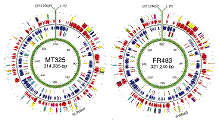Virology, Nebraska Center for
Document Type
Article
Date of this Version
6-2007
Abstract
The replication and transcription activator (RTA) protein of Kaposi’s sarcoma (KS)-associated herpesvirus (KSHV)/human herpesvirus 8 functions as the key regulator to induce KSHV lytic replication from latency through activation of the lytic cascade of KSHV. Elucidation of the host factors involved in RTA-mediated transcriptional activation is pivotal for understanding the transition between viral latency and lytic replication. KSHV-RTA binding protein (K-RBP) was previously isolated as a cellular RTA binding protein of unknown function. Sequence analysis showed that K-RBP contains a Kruppel-associated box (KRAB) at the N terminus and 12 adjacent zinc finger motifs. In similarity to other KRAB-containing zinc finger proteins, K-RBP is a transcriptional repressor. Mutational analysis revealed that the KRAB domain is responsible for the transcriptional suppression activity of this protein and that the repression is histone deacetylase independent. K-RBP was found to repress RTA-mediated transactivation and interact with TIF1β (transcription intermediary factor 1β), a common corepressor of KRAB-containing protein, to synergize with K-RBP in repression. Overexpression and knockdown experiment results suggest that K-RBP is a suppressor of RTA-mediated KSHV reactivation. Our findings suggest that the KRAB-containing zinc finger protein K-RBP can suppress RTA-mediated transactivation and KSHV lytic replication and that KSHV utilizes this protein as a regulator to maintain a balance between latency and lytic replication.


Comments
Published in JOURNAL OF VIROLOGY, June 2007, p. 6294–6306 Vol. 81, No. 12 0022-538X/07/$08.00+0 doi:10.1128/JVI.02648-06 Copyright © 2007, American Society for Microbiology. Used by permission.